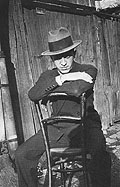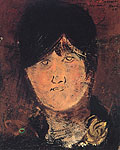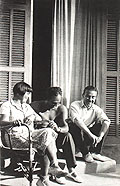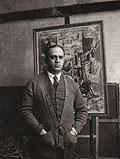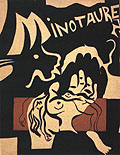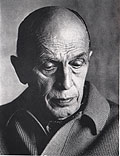|
|
|
|
|
Biography
| 1898 |
Bores is born
in Madrid on 6th May. |
||
| 1915 |
After finishing his studies
in the School of the Conception, he studies Engineering and Law
but leaves both degrees unfinished in order to dedicate more time
to painting. |
||
| 1916 |
He enters the
Cecilio Pla academy, where he will remain for three years. He studies
with models for the first time. He studies together with Pancho
Cossío, Manuel Ángeles Ortiz and Joaquin Peinado, amongst others. |
||
| 1921 | His works are
rejected by the National Exhibition. |
||
| 1922 | He participates
in the National Exhibition of Fine Art or Salones Oficiales. |
||
| 1923 |
He is in touch
with the Ultraist movement. He frequents literary circles and participates
in important literary gatherings. From then until 1928, he publishes
woodcuts in numerous magazines, such as Alfar, Horizonte, Tobogán,
Cruz y Raya, Indice, Sí and España. He produces
numerous vignettes for the covers of the Revista de Occidente.
He attends the Julio Moisés Academy, where he coincides with Dalí
and Benjamín Palencia . |
||
| 1925 |
|
||
| 1926 |
Summer spent in Juan-les-Pins,
where he meets with Joaquín Peinado and Sabartés, amongst others. |
||
| 1927 |
|
||
| 1928 |
|
||
| 1929 |
He begins to paint in a
less abstract way. In the summer, he travels to Grasse and Cros-de-Cagnes,
accompanied by Raïa Perewozka, whom he had met in 1928 in Paris
in the Café du Dôme. "... a stay in the Midi, near Grasse, precipitates
things: I felt subjugated by the light, the fruits, the women of
that region. And again I began to paint landscapes and figures ". |
||
| 1930 |
|
||
| 1931 |
|
||
| 1932 | Single artist
exhibition at the Galerie Vavin-Raspail. "More precision in form and
more intensity in colour.... New exploration of pure painting through
a motif of lesser importance." He spends the summer at Vinaroz with his family; he paints landscapes. |
||
| 1933 | Single artist
exhibition at the Galerie Vavin-Raspail, with works whose "themes
show more realism". He takes part in an exhibition held by the Iberian Artists' Society in Berlín and in a group exhibition at the Galerie Vavin-Raspail. Holidays with his family and Pierre Reverdy at Varangeville, where he coincides with Georges Braque and his wife. He moves his studio to Rue de la Glacière, where he lives with Raïa and his daughter. For financial reasons, Raïa and his daughter Carmen move to Madrid to live with his mother. |
||
| 1934 |
|
||
| 1935 |
Contract with
the Zwemmer Gallery in London to hold a single artist exhibition
in November. |
||
| 1936 |
He takes part
in the exhibition L´art espagnol contemporain at theJeu de
Paume in Paris. |
||
| 1937 |
He moves to
the Rue Villa Saint-Jacques, where he will remain until the end
of his life. |
||
| 1938 | Single
artist exhibition at the Stanley Rose Gallery in Hollywood |
||
| 1939 | Single
artist exhibition at the Buchholz Gallery in New York. The Second
World War breaks out. He and his family move to San Juan de Luz. |
||
| 1940 |
|
||
| 1941 |
He and his family
return to Paris. |
||
| 1942 |
He works with
the Galerie Renou et Colle. |
||
| 1943 |
In view of the
worsening situation in France, he travels to Madrid with his family.
He returns to Paris in September, but his family will remain in
Spain until 1945. |
||
| 1944 |
He paints one
of his few large works from that period: L´Eté. Single artist
exhibition at the Galerie Renou et Colle. |
||
| 1945 |
He takes part
in numerous group exhibitions, both in France and abroad: Brussels,
Rome, New York, Dublin, Ottawa, Luxembourg and The Hague. |
||
| 1946 |
Two single artist
exhibitions at the Galerie de France in Paris and the Galeries Apollo
in Brussels. |
||
| 1947 |
French museums
purchase his work Nature morte au biscuit, one of the numerous
acquisitions that they will continue to make until the sixties,
thereby attaining a large representation of Bores' work, which is
distributed amongst the museums and The National Foundation. |
||
| 1948 |
Single artist
exhibition at the Kunstforeningen in Copenhagen. |
||
| 1949 |
Four single
artist exhibitions at the Galerie Moos in Geneva and Zurich, at
the Galerie Per in Oslo and at the Galerie de France in Paris. |
||
| 1950 |
Single artist
exhibitions at the Galerie Pierre in Paris, at the Birchs Kunsthandel
in Copenhagen, and at the Konstmuseum in Aalborg. |
||
| 1951 |
He forms part
of the group of artists who collaborate with the Galerie Louis Carré
in Paris. |
||
| 1952 |
He takes part
in the Malerei en París Heute exhibition at the Kunsthaus
in Zurich. |
||
| 1953 |
He takes part
in various group exhibitions in Lausanne, Turin, Gotteburg, Japan,
Australia, Israel and also at the Galerie Louis Carré. |
||
| 1954 |
First single
artist exhibition at the Galerie Louis Carré, with works
ranging from 1951 to 1954. A catalogue is published with illustrations
and vignettes by Bores and a presentation text by Tériade. |
||
| 1955 |
He takes part
in numerous group exhibitions. |
||
| 1956 |
Single artist
exhibition at the Galerie Louis Carré with the catalogue prologue
written by Jacques Lassaigne. |
||
| 1957 |
Single artist
exhibition at the Galerie Louis Carré, with the catalogue prologue
by Jacques Lassaigne and an interview by Jean-José Marchand.
|
||
| 1958 |
|
||
| 1959 |
Second collaboration
with the Carnegie Institute Award in Pittsburgh with Nu devant
la mer (1957). |
||
| 1960 |
Three single
artist exhibitions, two in New York at the Albert Loeb Gallery and
the Pierre Berés Inc., and another at the Molton Gallery in London,
mainly of works on paper. |
||
| 1961 |
|
||
| 1962 |
Single artist
exhibition at the Galerie Louis Carré in Paris. |
||
| 1963 |
Exhibition of
selected works at the Crane Kalman Gallery in London. |
||
| 1964 |
First exhibition
of gouaches at the Galerie Villand et Galanis in Paris. He designs
stained glass windows for the Chapel of the Montbrison Seminary
in France, and he produces a series of five linen prints to illustrate
El llanto por la muerte de Ignacio Sánchez Mejias, by Federico
García Lorca, for a German publication. |
||
| 1966 |
He is nominated
Officier de L'Ordre des Arts et des Lettres. Single artist exhibition
at the Galerie Villand et Galanis, with the catalogue prologue written
by R.V. Gindertael. |
||
| 1967 |
Two single artist
exhibitions at the Galleria Pagani in Milan and at the Galerie Villand
et Galanis. |
||
| 1968 |
He paints very
few oils but experiments with felt tip pens, thereby leaving a large
collection of drawings which have very special characteristics |
||
| 1969 |
Single artist exhibition of gouaches at the Galerie Georges Bongers
in Paris. He participates in two group exhibitions: at the Crane Kalman Gallery and at the Galería Theo in Madrid. |
||
| 1970 | Single artist exhibition of gouaches in Esch s/Alzette, Luxembourg. | ||
| 1971 |
|
||
| 1972 | Francisco Bores dies in Paris on 10th May. |

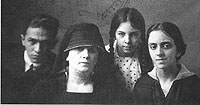
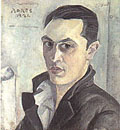 Self Portrait, 1926
Self Portrait, 1926
